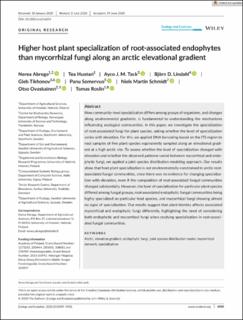| dc.contributor.author | Abrego, Nerea | |
| dc.contributor.author | Huotari, Tea | |
| dc.contributor.author | Tack, Ayco J.M. | |
| dc.contributor.author | Lindahl, Björn D. | |
| dc.contributor.author | Tikhonov, Gleb | |
| dc.contributor.author | Somervuo, Panu | |
| dc.contributor.author | Schmidt, Niels Martin | |
| dc.contributor.author | Ovaskainen, Otso | |
| dc.contributor.author | Roslin, Tomas | |
| dc.date.accessioned | 2022-09-02T10:01:22Z | |
| dc.date.available | 2022-09-02T10:01:22Z | |
| dc.date.created | 2021-01-27T15:23:51Z | |
| dc.date.issued | 2020 | |
| dc.identifier.citation | Ecology and Evolution. 2020, 10 8989-9002. | en_US |
| dc.identifier.issn | 2045-7758 | |
| dc.identifier.uri | https://hdl.handle.net/11250/3015361 | |
| dc.description.abstract | How community-level specialization differs among groups of organisms, and changes along environmental gradients, is fundamental to understanding the mechanisms influencing ecological communities. In this paper, we investigate the specialization of root-associated fungi for plant species, asking whether the level of specialization varies with elevation. For this, we applied DNA barcoding based on the ITS region to root samples of five plant species equivalently sampled along an elevational gradient at a high arctic site. To assess whether the level of specialization changed with elevation and whether the observed patterns varied between mycorrhizal and endophytic fungi, we applied a joint species distribution modeling approach. Our results show that host plant specialization is not environmentally constrained in arctic root-associated fungal communities, since there was no evidence for changing specialization with elevation, even if the composition of root-associated fungal communities changed substantially. However, the level of specialization for particular plant species differed among fungal groups, root-associated endophytic fungal communities being highly specialized on particular host species, and mycorrhizal fungi showing almost no signs of specialization. Our results suggest that plant identity affects associated mycorrhizal and endophytic fungi differently, highlighting the need of considering both endophytic and mycorrhizal fungi when studying specialization in root-associated fungal communities. | en_US |
| dc.language.iso | eng | en_US |
| dc.publisher | Wiley Open Access | en_US |
| dc.rights | Navngivelse 4.0 Internasjonal | * |
| dc.rights.uri | http://creativecommons.org/licenses/by/4.0/deed.no | * |
| dc.title | Higher host plant specialization of root-associated endophytes than mycorrhizal fungi along an arctic elevational gradient | en_US |
| dc.title.alternative | Higher host plant specialization of root-associated endophytes than mycorrhizal fungi along an arctic elevational gradient | en_US |
| dc.type | Peer reviewed | en_US |
| dc.type | Journal article | en_US |
| dc.description.version | publishedVersion | en_US |
| dc.source.pagenumber | 8989-9002 | en_US |
| dc.source.volume | 10 | en_US |
| dc.source.journal | Ecology and Evolution | en_US |
| dc.identifier.doi | 10.1002/ece3.6604 | |
| dc.identifier.cristin | 1880509 | |
| dc.relation.project | Norges forskningsråd: 223257 | en_US |
| cristin.ispublished | true | |
| cristin.fulltext | original | |
| cristin.qualitycode | 1 | |

